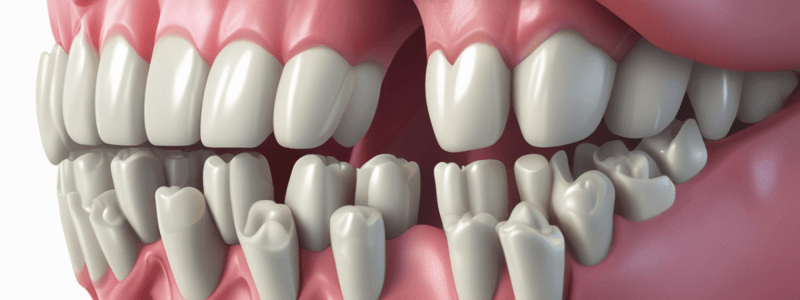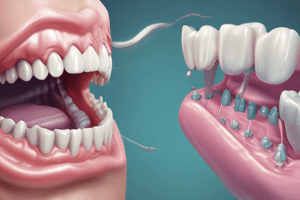Podcast
Questions and Answers
What is the origin of Neisseria gonorrhea-induced gingival disease?
What is the origin of Neisseria gonorrhea-induced gingival disease?
- Fungal origin
- Bacterial origin (correct)
- Genetic origin
- Viral origin
What is the name of the fungal species that causes generalized gingival candidiasis?
What is the name of the fungal species that causes generalized gingival candidiasis?
- Treponema
- Candida (correct)
- Streptococcus
- Histoplasma
Which of the following is an example of a mucocutaneous lesion?
Which of the following is an example of a mucocutaneous lesion?
- Primary herpetic gingivostomatitis
- Lupus erythematosus (correct)
- Hereditary gingival fibromatosis
- Gingival recession
What is the term for a reaction caused by dental restorative materials?
What is the term for a reaction caused by dental restorative materials?
What is the term for a localized tooth-related factor that modifies or predisposes to plaque-induced gingival disease?
What is the term for a localized tooth-related factor that modifies or predisposes to plaque-induced gingival disease?
What is the term for a condition caused by a foreign body in the gingiva?
What is the term for a condition caused by a foreign body in the gingiva?
What is the term for a gingival disease caused by a specific bacterial origin?
What is the term for a gingival disease caused by a specific bacterial origin?
What is the term for a mucogingival deformity that affects the facial or lingual surfaces of teeth?
What is the term for a mucogingival deformity that affects the facial or lingual surfaces of teeth?
What is the main purpose of classifying periodontal diseases?
What is the main purpose of classifying periodontal diseases?
What is the name of the paradigm that explains the nature of periodontal diseases from 1970 to present?
What is the name of the paradigm that explains the nature of periodontal diseases from 1970 to present?
What is the name of the 1993 classification of periodontal diseases?
What is the name of the 1993 classification of periodontal diseases?
What is the name of the classification system developed in 1989?
What is the name of the classification system developed in 1989?
What is the main drawback of the AAP 1989 classification?
What is the main drawback of the AAP 1989 classification?
What is the first category of periodontal disease in the AAP 1999 classification?
What is the first category of periodontal disease in the AAP 1999 classification?
What is the purpose of paradigms in understanding periodontal diseases?
What is the purpose of paradigms in understanding periodontal diseases?
What is the purpose of formulating individualized treatment plans?
What is the purpose of formulating individualized treatment plans?
What type of periodontitis occurs as a manifestation of systemic diseases?
What type of periodontitis occurs as a manifestation of systemic diseases?
What is the term for an abscess that occurs around a partially erupting tooth?
What is the term for an abscess that occurs around a partially erupting tooth?
What type of gingivitis is associated with dental plaque only and has no local contributing factors?
What type of gingivitis is associated with dental plaque only and has no local contributing factors?
What type of gingival disease is modified by endocrine system factors?
What type of gingival disease is modified by endocrine system factors?
What is the term for a gingival disease that is influenced by ascorbic acid deficiency?
What is the term for a gingival disease that is influenced by ascorbic acid deficiency?
What type of periodontitis is characterized by necrotizing ulceration?
What type of periodontitis is characterized by necrotizing ulceration?
What is the term for a lesion that combines an endodontic lesion and a periodontal lesion?
What is the term for a lesion that combines an endodontic lesion and a periodontal lesion?
What is the term for a periodontal abscess that occurs in the gingiva?
What is the term for a periodontal abscess that occurs in the gingiva?
What is one of the signs of gingival excess?
What is one of the signs of gingival excess?
Which of the following is a type of periodontal disease?
Which of the following is a type of periodontal disease?
What is the main indicator for gingivitis?
What is the main indicator for gingivitis?
What is the term for lack of keratinized tissue?
What is the term for lack of keratinized tissue?
What is the purpose of the new classification system for periodontal and peri-implant diseases?
What is the purpose of the new classification system for periodontal and peri-implant diseases?
What is the term for the vertical and/or horizontal deficiency of the ridge?
What is the term for the vertical and/or horizontal deficiency of the ridge?
What is the importance of recording the greatest reading in periodontal disease assessment?
What is the importance of recording the greatest reading in periodontal disease assessment?
What is the term for the soft tissue surrounding a tooth?
What is the term for the soft tissue surrounding a tooth?
Flashcards are hidden until you start studying
Study Notes
Classification of Periodontal Diseases and Conditions
- Definition: A systematic arrangement of groups with common attributes to aid clinical and laboratory diagnosis and specific treatments.
- Purpose: Communicate clinical findings accurately, present information to patients, formulate individualized treatment plans, and predict treatment outcomes.
Paradigms of Periodontal Diseases
- Clinical Characteristics Paradigm (1870-1920)
- Classical Pathology Paradigm (1920-1970)
- Infection/Host Response Paradigm (1970-present)
AAP 1989 Classification
- Adult Periodontitis
- Early Periodontitis (prepubertal, juvenile, rapidly progressive)
- Periodontitis associated with Systemic Disease
- Necrotizing Periodontitis
- Refractory Periodontitis
European Workshop Classification (1993)
- Adult Periodontitis
- Early Onset Periodontitis
- Necrotizing Periodontitis
AAP 1999 Classification
- Gingival Diseases:
- Plaque-induced Gingival Diseases
- Non-plaque-induced Gingival Diseases
- Chronic Periodontitis:
- Localized
- Generalized
- Aggressive Periodontitis:
- Localized
- Generalized
- Periodontitis as a Manifestation of Systemic Diseases
- Necrotizing Periodontal Diseases:
- Necrotizing Ulcerative Gingivitis (NUG)
- Necrotizing Ulcerative Periodontitis (NUP)
- Abscesses of the Periodontium:
- Gingival Abscess
- Periodontal Abscess
- Pericoronal Abscess
- Periodontitis associated with Endodontic Lesions:
- Endodontic-Periodontal Lesion
- Periodontal-Endodontic Lesion
- Combined Lesion
- Developmental or Acquired Deformities and Conditions:
- Localized Tooth-related Factors
- Mucogingival Deformities and Conditions
- Occlusal Trauma
Gingival Diseases
- Plaque-induced Gingival Diseases
- Gingivitis associated with Dental Plaque only
- Without local contributing factors
- With local contributing factors
- Gingival Diseases modified by Systemic Factors:
- Associated with Endocrine System
- Associated with Blood Dyscrasias
- Gingival Diseases modified by Medications:
- Drug-influenced Gingival Diseases
- Gingival Diseases modified by Malnutrition:
- Ascorbic Acid Deficiency Gingivitis
- Others
Non-Plaque-induced Gingival Diseases
- Gingival Diseases of Specific Bacterial Origin:
- Neisseria Gonorrhea
- Treponema Pallidum
- Streptococcal Species
- Gingival Diseases of Viral Origin:
- Herpes Virus Infections
- Primary Herpetic Gingivostomatitis
- Gingival Diseases of Fungal Origin:
- Candida-species Infections
- Linear Gingival Erythema
- Gingival Diseases of Genetic Origin:
- Hereditary Gingival Fibromatosis
- Gingival Manifestations of Systemic Conditions:
- Mucocutaneous Lesions
- Allergic Reactions
- Traumatic Lesions
- Foreign Body Reactions
- Not Otherwise Specified
Developmental/Acquired Deformities and Conditions
- Developmental or Acquired Deformities and Conditions
- Localized Tooth-related Factors
- Mucogingival Deformities and Conditions around Teeth:
- Gingival or Soft Tissue Recession
- Lack of Keratinized Gingiva
- Decreased Vestibular Depth
- Aberrant Frenum or Muscle Position
- Mucogingival Deformities and Conditions on Edentulous Ridges:
- Vertical and/or Horizontal Ridge Deficiency
- Lack of Gingiva or Keratinized Tissue
- Gingival or Soft Tissue Enlargements
- Occlusal Trauma:
- Primary Occlusal Trauma
- Secondary Occlusal Trauma
Studying That Suits You
Use AI to generate personalized quizzes and flashcards to suit your learning preferences.




